|
Jammu & Kashmir
Amarnath Yatra
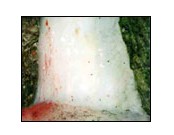 Situated
at a height of 3,880 metres in the Himalayas, the cave
enshrines a naturally formed ice-lingam, symbol of Lord
Shiva, which waxes and wanes with the moon, reaching
its maximum dimensions on the day of pilgrimage. This
is where, Hindus believe, Lord Shiva explained the secret
of salvation to his consort Parvati on a full moon night.
Every year in the month of Shravana (July-August), when
the moon is full, thousands of devout pilgrims gather
before Amarnath Cave in the picturesque Lidder Valley
in Kashmir to offer their prayers to Lord Shiva. Situated
at a height of 3,880 metres in the Himalayas, the cave
enshrines a naturally formed ice-lingam, symbol of Lord
Shiva, which waxes and wanes with the moon, reaching
its maximum dimensions on the day of pilgrimage. This
is where, Hindus believe, Lord Shiva explained the secret
of salvation to his consort Parvati on a full moon night.
Every year in the month of Shravana (July-August), when
the moon is full, thousands of devout pilgrims gather
before Amarnath Cave in the picturesque Lidder Valley
in Kashmir to offer their prayers to Lord Shiva.
General Information :
Altitude : 3880-4218 metres.
Clothings : Heavy woollens with raincoat.
Languages Spoken : Kashmiri, Hindi, English.
Best Season : Mid-June to Mid-October.
Access
Air : Nearest airport Srinagar (94 kms from Pahalgam)
is directly connected by Delhi, Jammu and Leh.
Rail: Nearest railway station Jammu-Tawi (335 kms from
Amarnath & 287 kms from Pahalgam) is connected by
rail to all the main cities in India.
Road: J&K Road Transport and Private Transports
operate buses from Shrinagar & and Jammu to Pahalgam,
from where the remaining 48 kms to the Amarnath Cave
is to be covered by ponies or on foot. Pahalgam is connected
by road to Jammu (335 kms), Shrinagar (94 kms), Ambala
Cantt (678 kms), Patnitop (180 kms),Pathankot (394 kms),
Delhi (870 kms), Ludhiana (565 kms), Jalandhar Cantt.(512
kms), Punch (231 kms), Anantnag (44 kms), Udhampur (226
kms).
Trek to Cave :
Amarnath yatra view of holy cave from outside
Assistant Director, Tourism, Pahalgam, J&K, operates
tours to the Amarnath Cave.
The itinerary for the Yatra follows as under
1st day : Pahalgam- Chandanwari (16 kms)
2nd day : Chandanbari- Shesnag (13 kms)
3rd day : Shesnag- Panchtarani (13 kms)
4th day : Panchtarani- Shri Amarnath Cave (6 kms). A
short trek to Amarnath Cave via Sonamarg & Baltal
is 30 kms.
Arrangements : Govt. of J&K and some private organizations
make all arrangements including Tent, Pony, Labourer,
and Dandi.
Load limit : Pony- 70 kgs, Labourer- 30 kgs.
Accommodation & Food :
Amarnath, natural Shiva Lingam
Beside hotels, number of huts, private houses &
tents are available at Pahalgam.
For night-halts at Chandanwari, Shesnag and Panchtarani
tourists are advised to fix up proper arrangements of
shelter before starting the journey from Pahalgam. Tents
can be hired on fixed rate from different camping agencies
at Pahalgam to be carried along from stage to stage.
Tents at these stations are pitched by the Dept. of
Tourism, Govt. of J&K through private camping agencies
in advance.
Accommodation in these tents is allotted in advance
against the payment of fixed charges per head for entire
Yatra Period.
Advance reservation in all these cases can be obtained
with the assistance of Tourist Officer, Dept of Tourism,
Govt of J&K, Pahalgam, who may be approached in
time specifying the requirements clearly.
A number of Dhabas and small wayside Tea Shops are
set up at all the halting stations of the Yatra by Private
parties during the yatra days.
Useful Information
Week's supply of essential commodities & provisions
should be carried along with. Also necessary tinned
food, a thermos, torch, raincoat, waterproof shoes,
heavy woollens, gumboots, walking stick and first aid
equipments. All requirements are available at Pahalgam.
The entire yatra is usually completed in 5 to 6 days.
The route is generally kept open from late June to the
end of September.
Information Centre :
Indiatourism Office,
88 Janpath, NewDelhi-110001,
Tel:23320005/8
Website: www.incredibleindia.org
E-Mail: goitodelhi@tourism.nic.in
Jammu & Kashmir Tourist Office,
A-3, Ring Road,
South Extension,
Part -I, New Delhi,
Tel: 24620027/ 51708223/24
Gulmarg
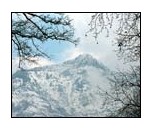 Gulmarg's
legendary beauty, prime location and proximity to Srinagar
naturally make it one of the premier hill resorts in
the country. Originally called 'Gaurimarg' by shepherds,
its present name was given in the 16th century by Sultan
Yusuf Shah, who was inspired by the sight of its grassy
slopes emblazoned with wild flowers. Gulmarg was a favourite
haunt of Emperor Jehangir who once collected 21 different
varieties of flowers from here. Today Gulmarg is not
merely a mountain resort of exceptional beauty- it also
has the highest green golf course in the world, at an
altitude of 2,650 m, and is the country's premier ski
resort in the winter. Gulmarg's
legendary beauty, prime location and proximity to Srinagar
naturally make it one of the premier hill resorts in
the country. Originally called 'Gaurimarg' by shepherds,
its present name was given in the 16th century by Sultan
Yusuf Shah, who was inspired by the sight of its grassy
slopes emblazoned with wild flowers. Gulmarg was a favourite
haunt of Emperor Jehangir who once collected 21 different
varieties of flowers from here. Today Gulmarg is not
merely a mountain resort of exceptional beauty- it also
has the highest green golf course in the world, at an
altitude of 2,650 m, and is the country's premier ski
resort in the winter.
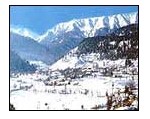 The
journey to Gulmarg is almost nearly as enchanting as
reaching there-- roads bordered by rigid avenues of
poplar give over to flat expanses of rice fields interspersed
with picturesque villages. Depending on the season,
nature's colours could be the translucent green of spring,
summer's rich emerald, or autumn's golden hues, when
scarlet chillies festoon windows of village homes. After
Tangmarg, the climb to Gulmarg begins through fir-covered
hillsides. At one point, known simply as View Point,
travellers generally stop their vehicles for a few minutes
and look out a spectacle of snow-covered mountains,
almost within touching distance. The
journey to Gulmarg is almost nearly as enchanting as
reaching there-- roads bordered by rigid avenues of
poplar give over to flat expanses of rice fields interspersed
with picturesque villages. Depending on the season,
nature's colours could be the translucent green of spring,
summer's rich emerald, or autumn's golden hues, when
scarlet chillies festoon windows of village homes. After
Tangmarg, the climb to Gulmarg begins through fir-covered
hillsides. At one point, known simply as View Point,
travellers generally stop their vehicles for a few minutes
and look out a spectacle of snow-covered mountains,
almost within touching distance.
General Information
Area : 3.5 km long; 1km wide Altitude 2,650 m
Best season : Throughout the year.
Clothing: Summer : Light woollens; winter: Heavy woollens
Access
Gulmarg is 56 kms from Srinagar. J&K SRTC operates
regular deluxe and ordinary bus services from Srinagar.
In winter, the buses operate up to Tangmarg (11 kms
from Gulmarg), the remaining distance being covered
with smaller vehicles. Tourist taxis also operate between
Srinagar and Gulmarg.
Accommodation
Hotel Highlands Park (3 Star Hotel)
Gulmarg - Kashmir, Gulmarg
Hotel Hilltop (3 Star Hotel)
Gulmarg , Gulmarg
Things to Do
Golfing Holidays - Gulmarg in summers - It is for golfing
that Gulmarg has long been famous. The Gulmarg Golf
Club has been in existence for over a hundred years
and there are records, dating from that time, which
make fascinating reading. The Clubhouse itself, reminiscent
of a Swiss chalet with its quaintly sloping roof, has
a rare old character. Temporary members are also welcome:
the payment of a daily fee entitles one to play 18 holes
on course maintained by the State Tourism Department.
A limited supply of golfing equipment is available for
hire.
Horse Riding - This is the best activity by which all
the sites of Gulmarg can be seen. Horses can be hired
directly or through the Tourist Office.
Sledging - Sledging at Gulmarg - A flat wooden board
is taken up the hilltop and, without a navigator, allowed
to slide downhill on the snow-covered slopes. Sledges
as well as sledge-pullers are always available on hire.
Skiing & Winter Sports - Some of the best slopes
in the country for beginners and intermediate skiers
are available at Gulmarg. Skiing equipment is available
on hire from the Ski-Shop. In winter Gulmarg's natural
slopes and inclines turn into the country's premier
skiing resort. Not all tourists who visit in winter
come for skiing - some simply are there to watch the
skiing or to enjoy a holiday in the snow. Many of these
are infected with the excitement of the skiers, and
have donned their first pair of skis within a short
while of their arrival.
Snowmobile ride in Gulmarg - Among the multitudes of
slopes, there are a few which are serviced by ski lifts.
Most of the skiing becomes centred on these slopes,
which are specially suited to beginners and intermediate
level skiers, with ski runs ranging from 200 m to 3kms,
instructors are available for both levels. As in the
summer, when each individual sets his own pace for a
holiday, so also in winter, skiing can be as adventurous
as the holidaymaker can want. There are a number of
slopes, not serviced by ski lifts, of varying lengths
and gradients. Each of these is quieter than the immensely
popular ones with ski lifts. Advanced skiers often trek
in the snow for several hours to the very top of Apharwat
peak, to make a descent lasting no more than 30 minutes.
And now, with the operation of the Gulmarg Gondola Cable
Car, it has become all the more convenient for skiing
enthusiasts, as they can gain a ski run of nearly 3
kms with the help of this cable car which goes up to
Kongdori.
Tobogganing - There are a host of snow sports at Gulmarg.
Tobogganing, the most popular among them requires no
skill. No skill is required - a flat wooden board is
taken up the hill and is allowed to descend downhill.
There are also snow scooters and snow bobbing, neither
requiring special skills.
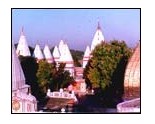 Jammu Jammu
Jammu is the Duggar land where the past still has
a living presence. It is the land of grand ancient temples,
and beautiful palaces all nestling in the foothills
of the Himalayas. It is said that, on becoming King,
the Suryavanshi Jambu Lochan went on a hunt and, crossing
the Tawi, found a deer and a tiger drinking water from
the same tank. His ministers explained that this meant
that the soil of the place was so virtuous that no living
creature bore enmity against another. Raja Jambu Lochan,
who lived in the later Vedic period, decided to found
his capital, Jambupura, on his soil, on the right bank
of the Tawi, overlooking his brother king Bahu's fort.
Today the temple of Maha Kali (better known as Bahu
or Bawey Wali Mata), located in the Bahufort, is considered
second only to Mata Vaishno Devi in terms of mystical
power. The present temple was built shortly after the
coronation of Maharaja Gulab Singh, in 1822. The existing
fort, as well as the Manasabdar's palace inside it,
was constructed in 1820.
Jammu is justly famous for its temples. In fact it
is known as the city of temples and the every fame of
its, tends to overshadow its palaces, forts, forests
and powerful ziarats. If Bahu Mata is the presiding
deity of Jammu, the Dargah of Peer Budhan Ali Shah is
the other shrine that protects Jammuites. The other
major tourist attraction is the Raghunath Temple Complex.
Maharaja Gulab Singh began the construction of the Raghunath
Mandir Complex in the crowded downtown Bazaar named
after it, in 1851. It was left to his son, Ranbir Singh,
to inaugurate it six years later perhaps the most popular
temple north of Benares, it contains representations
of almost entire Hindu pantheon, though the emphasis
falls on the various incarnations of Lord Vishnu. The
complex houses a rich collection of ancient texts and
manuscripts.
General Information
Area : 20.36 Sq km
Altitude : 305 mtrs
Rainfall : 107 cms (July to September)
Languages : Dogri, Hindi, English, Urdu, Kashmiri, Punjabi
Best Season : October to April
Temperatures : 26.2 to 4.3 degrees cent in winter. Temperatures
in summer 43.0 to 23.4
Clothing: Heavy / Medium woollens in winters to light
cottons in summers
Food : Every sort of vegetarian and non-vegetarian food
is available in multiple cuisines to suit every budget.
Restaurants of all hues and shades are available all
along the busy roads and other major spots.
Travels : Registered travel/tour operators are available.
Others : Tariffs are subject to change without notice
and Cheques are not accepted.
Important Road Distances :
Amritsar: 243 Kms Srinagar: 305 Kms
Chandigarh: 436 Kms Manali: 428 Kms
Delhi: 586 Kms Patnitop: 112 Kms
Katra: 48 Kms Mansar: 60 Kms
Places of Interest
Temples and Shrines
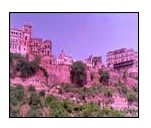 Amongst
the temples in Jammu, the Raghunath Mandir takes pride
of place being situated right in the heart of the city.
It consists of a cluster of temples and is the largest
temple complex in northern India. Its inner sanctums
contain gigantic statues of deities and numerous 'lingams'.
It contains representatives of almost the entire Hindu
pantheon, which make it a rare site to behold. Amongst
the temples in Jammu, the Raghunath Mandir takes pride
of place being situated right in the heart of the city.
It consists of a cluster of temples and is the largest
temple complex in northern India. Its inner sanctums
contain gigantic statues of deities and numerous 'lingams'.
It contains representatives of almost the entire Hindu
pantheon, which make it a rare site to behold.
Bawey Wali Mata Temple - The famous temple of Bawey
Wali Mata is inside the Bahu Fort where, every Tuesday
and Sunday, pilgrims throng to worship the goddess.
A little further away, on a spur opposite the Bahu Fort,
overlooking the river Tawi, stands a temple dedicated
to Mahamaya, a Dogra heroine who lost her life fourteen
centuries ago fighting foreign invaders.
The Peer Kho cave temple overlooking the Tawi River,
the Panchbakhtar temple and the Ranbireshwar temple
are the other well-known Shiva temples in Jammu.
Each has its own legend, its devotees and specific
days of worship. In Ranbireshwar Temple, there are twelve
Shiva 'lingams' of crystal measuring 12" to 18"
and galleries with thousands of 'saligrams' fixed on
stone slabs. Other important temples in Jammu are the
Lakshmi Narayan temple, Duda Dhari temple and the Panj
Mandir in Gandhi Nagar.
It is said that if the Bawey Wali Mata is the presiding
deity of Jammu, the 'durgah' of Peer Budhan Ali Shah
or Peer Baba as it is known, is the shrine that protects
the people of this city from mishaps and evil spirits.
A friend of Guru Gobind Singh, Peer Baba is said to
have lived his entire life on milk alone and lived to
the age of five hundred. On Thursdays, Hindu and Sikh
devotees vastly outnumber their Muslim brethren at this
shrine; such is the faith of the people in Peer Baba.
Most VIPs make it a point to visit this 'durgah' when
they come to Jammu.
Mubarak Mandi Palace, Jammu
Peer Mitha is another famous Muslim shrine in Jammu.
Peer Mitha was a contemporary of Ajaib Dev and Ghareeb
Nath - both saints were famous for their prophecies
and miracles. 'Mitha' means 'the sweet one', for the
Peer would accept nothing more than a pinch of sugar
in offering from his devotees.
Forts and Palaces
On the opposite bank of the Tawi river, on an upland
plateau, is situated the majestic Bahu Fort, the oldest
edifice extant in the region. Looking at this fort one
can imagine the wars fought, invasions prevented, and
yes, even the grandeur the royal family must have enjoyed
at the time. Today it is surrounded by a lush green
terraced garden, with waterfalls and flowers of just
about every kind and colour. It is a favourite picnic
spot for the city folk.
The Amar Mahal Palace, a sight to behold, is on an
eyrie overlooking the Tawi river. This grand palace,
with sloping roofs and tall towers, so characteristic
of continental castles, reminds one of France. The palace
has been converted into a museum, which also houses
the city's finest library of antique books and paintings.
An entire series of miniatures on the epic Nal-Damayanti
can be seen in the museum.
Old Bazaars and Designer boutiques
There are two charmingly contradictory aspects to the
city of Jammu which one can see while shopping. For
instance, in the crowded streets of Raghunath Bazaar,
among the age-old dry fruit shops, you'll find designer
boutiques that display the very latest in fashion and
fashion accessories.
Here the main bazaars - Vir Marg, Raghunath Bazaar
and Hari Market - are famous for Kashmiri handicrafts,
traditional Dogra jewellery and various dry fruits,
chiefly walnuts ('akhrot') and almonds. Jammu is also
known for the superlative quality of its 'basmati' rice,
'rajma' (red beans), 'ampapar' (dried and candied mango
peel), 'anardana' (dried pomegranate seeds) and 'barfi'
(milk sweets).For purchasing authentic Kashmiri handicrafts,
one can visit the J&K Government Arts Emporium near
the Tourist Reception Centre on Residency Road. The
emporium displays and sells a wide variety of handicrafts,
including Pashmina shawls and exquisite hand-knotted
carpets of silk and woo
Jammu - Excursions
Katra
50 kms from Jammu. This small town serves as the base
camp for visiting the famous shrine of Vaishnodeviji
in the Trikuta Hills. The shrine is approachable on
foot along a 12 kms long well laid footpath. Every year,
nearly 4 million pilgrims pass through Katra on their
way to Vaishnodeviji. Accommodation is available in
Tourist Bungalows, Yatrika and a number of private hotels,
beside pilgrims' serais.
Accommodation
Tourist Bungalow Tel no: 01991-232009
Tourist Retiring Centre Tel no: 01991-232309
Yatri Niwas Tel no: 01991-233261
Kud
106 kms from Jammu. This popular resort is situated
on the Jammu-Srinagar highway, at an altitude of 1738
metres. An ideal picnic spot this place has a bracing
climate. Heavy woollens are required in winters while
as light/medium clothing is required in summers. It
is a very well developed hill station in Udhampur District.
It also experiences heavy rainfall in rainy season.
Accommodation : Tourist Bungalow No I
How to Reach - Regular transport is available
from Jammu. Buses are available from General Bus stand
Jammu. JKTDC also makes available chartered luxury coaches
and buses. Alternatively Taxis can also be hired from
scores of Tour/Travel operators from across the city.
Similar services towards Kud are available from Railway
Station. Fares are pre determined by the Govt. and are
subject to change.
What to do
rekking - A range of Trekking options is available
here. Ask for a free Trekking Brochure. There are excellent
camping site in the adjoining areas in the wilderness.
The Sundarani-Jangal Gali-JasarKote-Sanasar route can
be taken from here. The tourism Department has Trekking
equipment Hire shop here. These Shops stock local and
Imported trekking gear. Equipment is available against
a security deposit. If you are a foreign national then
your passport will be kept as deposit. Some travel agencies
also organise trekking around this area.
Patnitop
112 kms from Jammu. This famous hill resort
is perched on a beautiful plateau, at an altitude of
2024 metres across which the Jammu-Srinagar Highway
passes. Enveloped by thickly wooded forests, Patnitop
offers beautiful picnic spots, peaceful walks and breathtaking
views of the mountains cape of the Chenab basin. In
winter, the resort is generally covered with a thick
mantle of snow thus providing opportunities for various
snow games including skiing. It is the best-developed
tourist spot of Jammu and is second to none in its natural
charm, climate, pine forests and lush green cover. The
occupancy of the huts and Dak Bungalow is full in summer
months. There is ambitious plan of Patnitop Development
Authority to develop Patnitop, Kud, Sud-Mahadev, Mantalai
circuit. The construction work of Mall Road at Kud is
also proposed to be taken up. Trekking route from Kud
to Patnitop-Sanasar has already been completed. The
complete tourist circuit covers Jammu-Katra-Vaishno
Deviji, Kud-Sanasar, Patnitop-Gourikund, Sudmahadev,
Mantali, extending up to Latti-Dhuna.
Accommodation : There are a large number of huts and
Tourists Bungalows, all managed by J&K TDC, Having
facilities of Drawing room/Dining room and fully equipped
kitchen in all huts and LPG facility.
1. Patni Enclave
2. Huts in Padora Village (Two kilometres from Patni
Enclave)
3. Tourist Bungalow No. I & II
4. Tented accommodation for economy class (Summer months
only)
What to do
Trekking - A range of trekking options is available
here. Summer is the season when all trekking routes
are open while some are open in winter too. There are
excellent camping sites also enroute. The Sundarani-
Jungal Gali-Jasarkote-Sanasar route in Jangal Gali area
lets you choose any of three exciting treks. For more
details check the Jangal Gali trek route in trekking
brochure available from JKTDC(Free). There are Trekking
equipment hire shops of tourism Deptt. at Jammu and
Kud. They stock imported and local gear. These are available
for fixed prices. The equipment is issued against cash
receipt or on Guarantee letter from Dy. Dir Tourism/Dy.
Secy of State or central govt. For a foreign tourist
Passport is held as security deposit. Some travel agencies
in Jammu city also organize Trekking in the area.
Skiing - Skiing courses are conducted at Patnitop
in the months of January and February. During winter
months there are introductory courses for tourists/beginners
at gentle gradient slopes of Patnitop. At Madhatop (5/6
Kms from Patni top on Sanasar Road) excellent possibilities
for all kind of skiing exist. A ski lift in the area
is also proposed. As for facilities 40 sets of equipment
is available at Patnitop and Sanasar. Also available
are wooden sledges locally. For beginners Instructors
are also available.
Accommodation for Skiers is also available in Huts
of JKTDC at Patnitop, KUD and Sanasar. Private Hotels
around the area also offer accommodation.
Aero sports - Paragliding has been introduced
at Sanasar and Jammu. Equipment is available on Hire
from tourist office in Jammu city. May-June and September
October are best suited for paragliding. Other aero
sports like Parasailing and Hot air ballooning are also
becoming operational shortly.
Sanasar
119 kms from Jammu and only 17 kms from Patnitop, Sanasar
is cup shaped meadow surrounded by gigantic conifers.
A place for a quite holiday, the meadow has now been
developed as a golf course. It also provides opportunities
for Para-gliding.
Accommodation : Self contained huts in various cost
ranges having facilities of Drawing/Dining room and
fully equipped kitchen with LPG facilities.
Batote
125 kms from Jammu situated at an altitude of 1560
metres on the Jammu-Srinagar National Highway, this
resort straddles the forested slopes of the Patnitop
mountain range, overlooking the spectacular lie of the
Chenab gorge. This place is a very well developed tourist
resort with lots of commercial activity and facilities.
Accommodation - Self contained huts having facilities
of Drawing/Dining room and fully equipped kitchen with
LPG facilities.
Access - This place is one the National highway
connecting Jammu and Srinagar and is well connected
thus. Buses plying to all Destinations viz. Srinagar,
Doda Bhaderwah, Kishtwar etc. pass through this resort.
The buses are available from General Bus Stand Jammu.
One can also hire taxis from Jammu, which ply on predetermined
rates. Ideally one can visit this resort while visiting
Patnitop. This place is approx 15 Kms beyond Patnitop
on the National Highway.
What to do
One can enjoy the beauty of Chenab gorge from this
place. Take long walks in deep jungles and enjoy the
beauty of coniferous forests camping in the jungles
Trek up to Sanasar and Patnitop.
Mantalai
Situated a few kilometers further away from Shud Mahadev,
lush deodar forests, at an altitude of over 2000 metres,
surround Mantalai. It is believed that Lord Shiva had
got married to the Goddess Parvati here.
Mansar Lake
60 kms. A beautiful lake fringed by forest-covered
hills. Boating facilities are available on the spot.
Every year around Baisakhi, a food and crafts festival
is organised here by J&K Tourism.
Accommodation : Tourist Bungalow and huts of J&K
TDC
Surinsar Mansar Wildlife Sanctuary
Named for the two lakes on each corner of it, this
sanctuary comprises an area of 98 sq. km and supports
a mammal population of 8 species and 15 species of birds.
Approach
Airport Jammu (58 Kms)
Railhead Jammu (56 Kms)
Road Jammu (42 Kms)
Area : 97.82 Kms
Flora : The mixed scrub forest comprises mainly of broad-leaved
species, which are mixed with
stands of Pinus gerardiana. The common broad-leaved
species are Acacia, Mallotus phillipensis,
dalbergia sissii, ficus religiosa, bahunia variegata.
Fauna : There are eight species viz., Goral, wild boar,
barking deer, leopard.
Avifauna : There is multitude of birds viz., black partridge,
red jungle fowl, peafowl, grey partridge,
green pigeon, blue rock pigeon, rufus turtle dove.
Visit : Mammal viewing September to March
Bird Viewing March to May
Dress
Spring/Summer Trekking Shoes, Raincoat, and light clothing
Winter Trekking Shoes, Heavy woollens and waterproof
windcheaters.
For Reservations Contact :
The Regional Wildlife Warden Jammu Region
Near Jammu Ashok Hotel Manda (Ramnagar)
Jammu, (Jammu and Kashmir)
Jhajjar Kotli
35 kms. On the National Highway leading towards Srinagar
is the Jajjar Kotli Tourist Complex, built on the banks
of Jajjar rivulet. The crystal clear, cool water of
Jajjar attracts picnickers in large numbers during the
summer. A Tourist Cafeteria, a Bar and a small Tourist
Bungalow are the facilities provided here by JKTDC.
Accommodation : Tourist Bungalow
Akhnoor
32 kms south west of Jammu situated on the banks of
mighty Chenab river is the historic town of Akhnoor.
This town is associated with the legend of Soni-Mahiwal.
Ruins of the Indus-Valley Civilization are to be seen
along the riverbank commanding a panoramic view all
around.
Mubarak Mandi Palace
The oldest building in this Palace complex date to
1824. The architecture is blend of Rajasthani, Mughal
and even Baroque European influences. The most stunning
segment is the Sheesh Mahal. The Pink Hall now houses
of Dogra Art Museum which has miniature paintings of
the various Hill Schools. The Complex has a history,
which is 150 years old. It was royal residence of Dogra
Kings. The location was carefully selected for having
a commanding view of river Tawi on one side and the
City on other side. The Palaces are built as a group
of buildings around a courtyard. The Complex has halls
and Galleries, which were used for official functions
and ceremonies. As the time passed the need was felt
to have separate buildings to house full-fledged Royal
Secretariat. These buildings were constructed around
a garden cum courtyard, which ultimately became the
venue for important events for Royal audience for common
man.
Dogra Art Gallery
This is located in the erstwhile Pink Hall of the old
Mubarak Mandi Palace Complex. This museum houses 800
rare and exquisite paintings from different schools
of paintings viz: Basohli, Jammu and Kangra. Gold painted
bow and arrow of Shah Jehan and a number carpentry tools
make an important section of the display. The museum
also has Shahnama and Sikandernama hand written manuscripts
in Persian.
Open in Winter: 10.30 a.m. - 04.30 p.m.
Summer: 08.00 a.m. - 01.30 p.m.
Fine miniatures of the Jammu and Basohli Schools. Closed
on Mondays.
How to Reach
This is situated right in the heart of the walled city.
You can take an Auto Rickshaw from almost anywhere in
the city as well as common mode of transport in form
of the minibuses can take you there for the payment
of nominal fare.
Amar Mahal Palace Museum
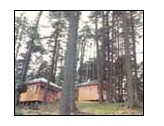 This
is a beautiful palace of red sand stone, which stands
amidst the most picturesque environments of Jammu. There
is beautiful view of the Shivaliks at the north and
the River Tawi flows down below adding to the Grandeur.
This was once the residential palace of Raja Amar Singh
the palace has been converted to a museum and is looked
after by Hari-Tara Charitable trust. The museum has
a golden throne made of 120 kg pure gold sofa and has
golden lions embedded into it. The throne is placed
in a hexagonal room. The museum has a gallery of paintings
of paintings known as NAL DAMYANTI. It has a library
of around 25000 books on various subjects and disciplines.
This is really a beautiful spot to be visited round
the year in Jammu. Hotel Hari Nivas Palace Hotel: A
heritage Hotel is also located adjacent to this. This
is a beautiful palace of red sand stone, which stands
amidst the most picturesque environments of Jammu. There
is beautiful view of the Shivaliks at the north and
the River Tawi flows down below adding to the Grandeur.
This was once the residential palace of Raja Amar Singh
the palace has been converted to a museum and is looked
after by Hari-Tara Charitable trust. The museum has
a golden throne made of 120 kg pure gold sofa and has
golden lions embedded into it. The throne is placed
in a hexagonal room. The museum has a gallery of paintings
of paintings known as NAL DAMYANTI. It has a library
of around 25000 books on various subjects and disciplines.
This is really a beautiful spot to be visited round
the year in Jammu. Hotel Hari Nivas Palace Hotel: A
heritage Hotel is also located adjacent to this.
How to Reach
Auto Rickshaws from anywhere in the Jammu city can
take you to this place on payment of nominal charges.
Minibuses do also ply but are not allowed to enter the
Palace complex so you have to walk up to the palace.
General information
Ramnagar, Tel: 5676
Open in Winter: 1000 to 1200hrs. and 1500 to 1700 hrs.
Summer : 1700 to 1900 hrs.
Sundays : 1000 to 1200 hrs.
Closed : State Holidays and Mondays.
Exhibits : Pahari paintings, family portraits of rulers
of Jammu and Kashmir, a library. Of interest by itself
is the building, a former palace designed like a French
Chateau, in which the museum is housed.
Kashmir
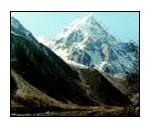 The
Mughal Emperor exclaimed "Gar Bar-ru-e-Zamin Ast;
Hamin Ast ,Hamin Ast Hamin Asto" - meaning "If
there is paradise on this earth: This is it, this is
it, this is it". The
Mughal Emperor exclaimed "Gar Bar-ru-e-Zamin Ast;
Hamin Ast ,Hamin Ast Hamin Asto" - meaning "If
there is paradise on this earth: This is it, this is
it, this is it".
If legends are to be believed, the Kashmir valley was
once a lake as large as a sea and here lived an abominable
demon who was killed after most of the lake had been
drained with the collective help of Lord Brahma's grandson,
Kashap and the goddess Parvati. She finally stilled
the demon by dropping upon him a mountain and thereby
crushing him to death. This legendary mountain is no
other than Hari Parbat, Srinagar's 'Takht-i- Sulaiman'
hill that forms the famous backdrop to the city.
Set like a jewelled crown on the map of India, Kashmir
is a multi-faceted diamond, changing its hues with the
seasons - always extravagantly beautiful. Two major
Himalayan ranges, the Great Himalayan Range and the
Pir Panjal, surround the landscape from the north and
south respectively. They are the source of great rivers,
which flow down into the valleys, forested with orchards
and decorated by lily-laden lakes.
The Mughals aptly called Kashmir 'Paradise on Earth.'
After they journeyed across the hot plains of India,
they vacationed in the valley's cool environs in summer.
Here they laid, with great love and care, Srinagar's
many formal, waterfront gardens, now collectively known
as the Mughal Gardens. Anecdotes of four and five centuries
ago describe their love for these gardens, and the rivalries
that centred on their ownership. They also patronized
the development of art & craft among the people
of Kashmir, leaving behind a heritage of exquisite artisanship
among these people and making the handicrafts of the
land prized gifts all over the world.
Kashmir is a land where myriad holiday ideas are realised.
In winter, when snow carpets the mountains, there is
skiing, tobogganing, sledge-riding, etc. along the gentle
slopes. In spring and summer, the honey-dewed orchards,
rippling lakes and blue skies beckon every soul to sample
the many delights the mountains and valleys have to
offer. Golfing at 2,700 m above the sea, water-skiing
in the lakes and angling for prized rainbow trout, or
simply drifting down the willow fringed alleys of lakes
in shikaras and living in gorgeous houseboats are some
of the most favoured ones.
Kashmir has four distinct seasons, each with its own
peculiar character and distinctive charm. These are
spring, summer, autumn and winter. Spring, which extends
roughly from March to early May, is when a million blossoms
carpet the ground. The weather during this time can
be gloriously pleasant at 23oC or chilly and windy at
6oC. This is the season when Srinagar experiences rains,
but the showers are brief.
Summer extends from May until the end of August. Light
woollens may be required to wear out of Srinagar. In
higher altitudes night temperatures drop slightly. Srinagar
at this time experiences day temperatures of between
25oC and 35oC. At this time, the whole valley is a mosaic
of varying shades of green - rice fields, meadows, trees,
etc. and Srinagar with its lakes and waterways is a
heaven after the scorching heat of the Indian plains.
The onset of autumn, perhaps Kashmir's loveliest season,
is towards September, when green turns to gold and then
to russet and red. The highest day temperatures in September
are around 23oC and night temperatures dip to 10oC by
October, and further drop by November, when heavy woollens
are essential.
Through December, to the beginning of March is wintertime,
which presents Srinagar in yet another mood. Bare, snow-covered
landscapes being watched from beside the warmth of a
fire is a joy that cannot be described to anyone who
has not experienced it. Some houseboats and hotels remain
open in winter-these are either centrally heated or
heated with 'bukharis', a typically Kashmiri stove kept
alight with embers of wood, quite effective in the winter.
Kargil
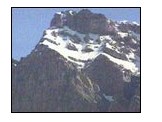 The
western parts of Ladakh comprising the river valleys,
which are drained and formed by the Himalayan tributaries
of the high Indus, constitute Kargil district. Prominent
among these are the spectacular valleys of Suru and
Zanskar, which lie nestled along the northern flank
of the Great Himalayan wall. The smaller lateral valleys
of Drass, Wakha-Mulbek and Chiktan constitute important
subsidiaries. The
western parts of Ladakh comprising the river valleys,
which are drained and formed by the Himalayan tributaries
of the high Indus, constitute Kargil district. Prominent
among these are the spectacular valleys of Suru and
Zanskar, which lie nestled along the northern flank
of the Great Himalayan wall. The smaller lateral valleys
of Drass, Wakha-Mulbek and Chiktan constitute important
subsidiaries.
This region formed part of the erstwhile Kingdom of
Ladakh. In fact it is believed to be the first to be
inhabited by the early colonizers of Ladakh, the Indo-Aryan
Mons from across the Great Himalayan range, assorted
Dard immigrants from down the Indus and the Gilgit valleys
and itinerant nomads from the Tibetan highlands. Also,
being contiguous with Baltistan, Kashmir, Kulu etc.
these valleys are believed to have served as the initial
recipients of successive ethnic and cultural influences
emanating from the neighbouring regions. Thus, while
the Mons are believed to have introduced north-Indian
Buddhism to these valleys, the Dard and Balti immigrants
are credited with introducing farming and the Tibetan
nomads with the tradition of herding and animal husbandry.
 About
15,000 sq. kms. in area, Kargil district has an agrarian
population of approximately 120,000 people, who cultivate
the land, along the course of the drainage system, wherever
artificial irrigation from mountain streams is possible.
About 85% are Muslims, mainly of the Shia sect, Islam
having been introduced to the original Buddhist population
around the middle of the 16th century by missionaries
from Kashmir and Central Asia. Their descendants, locally
titled Agha, are mostly religious scholars who continue
to hold sway over the population, even as the age-old
traditions of Buddhist and animistic origin are discernible
in the culture. Many elements of the ancient supernatural
belief systems, especially many traditions connected
with agricultural practices, are still followed with
subdued reverence. About
15,000 sq. kms. in area, Kargil district has an agrarian
population of approximately 120,000 people, who cultivate
the land, along the course of the drainage system, wherever
artificial irrigation from mountain streams is possible.
About 85% are Muslims, mainly of the Shia sect, Islam
having been introduced to the original Buddhist population
around the middle of the 16th century by missionaries
from Kashmir and Central Asia. Their descendants, locally
titled Agha, are mostly religious scholars who continue
to hold sway over the population, even as the age-old
traditions of Buddhist and animistic origin are discernible
in the culture. Many elements of the ancient supernatural
belief systems, especially many traditions connected
with agricultural practices, are still followed with
subdued reverence.
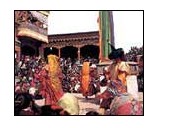 Ladakh Ladakh
Ladakh is a land abounding in awesome physical features,
set in an enormous and spectacular environment. Bounded
by two of the world's mightiest mountain ranges, the
Karakoram in the north and the Great Himalaya in the
south, it is traversed by two other parallel chains,
the Ladakh Range and the Zanskar Range.
In geological terms, this is a young land, formed a
few million years ago. Its basic contours, uplifted
by tectonic movements, have been modified over the millennia
by the process of erosion due to wind and water, sculpted
into the form that we see today.
Today a high-altitude desert, sheltered from the rain-bearing
clouds of the Indian monsoon by the barrier of the Great
Himalaya, Ladakh was once covered by an extensive lake
system, the vestiges of which still exist on its south-east
plateaux of Rupshu and Chushul, in the drainage basins
or lakes of Tso-moriri, Tso-kar and Pangong-tso. But
the main source of water is winter snowfall.
Dras, Zanskar and the Suru Valley on the Himalaya's
northern flanks receive heavy snow in winter, this feeds
the glaciers from which melt water, carried down by
streams, irrigates the fields in summer. For the rest
of the region, the snow on the peaks is virtually the
only source of water. As the crops grow, the villagers
pray not for rain, but for sun to melt the glaciers
and liberate their water.
Ladakh lies at altitudes ranging from about 9,000 ft
(2,750 m) at Kargil to 25,170 ft (7,672m) at Saser Kangri,
in the Karakoram Range. Summer temperatures rarely exceed
27C in the shade, while in winter they may at times
plummet to minus 20C even in Leh. Surprisingly though,
the thin air makes the heat of the sun even more intense
than at lower altitudes. It is said that only in Ladakh
can a man sitting in the sun with his feet in the shade
suffer from sunstroke and frostbite at the same time!
General Information
Area : 97,000 sq kms out of which nearly 38,000 sq.
kms are under Chinese Occupation since 1962.
Population : Approx. 2.40 lakh in the 2 districts of
Leh & Kargil.
Languages : Ladakhi including Balti / Purgi, Shina or
Dardic, Urdu / Hindi.
People : Mongoloid/Tibetan, Dardic and assorted Indo-Aryan
elements.
Altitude : Leh 3505 m, Kargil 2750 m
Temperature : Maximum Minimum
Summer 25 deg C 8 deg C
Winter (-) 5 deg C (-) 20 deg C
Rain-fall : 15 cm, 6" (annual average)
Clothing : Cotton & light woollens in summer and
heavy woollens including down-filled wind proof
upper garments in winter.
Ladakh - Access
Access
The Journey from Kashmir - The main overland approach
to Ladakh is from the Kashmir Valley through the 434-km
Srinagar-Leh highway, which follows the historic trade
route, also known as the 'Treaty Road'. It generally
remains open for traffic from early June to mid-November.
The Road journey from Manali - The 473 km Manali- Leh
Road is open for about three months in the year from
early July to September. For much of its length, it
passes through areas so barren that it is entirely void
of habitation. Lahoul district, through which the road
passes, is a typically trans-Himalayan landscape.
Transport Facilities
The J&K State Road Transport Corporation (J&K
SRTC) operates deluxe and regular buses between Srinagar
and Leh, with an overnight halt at Kargil. Taxis are
also available at Srinagar and Leh for the journey.
Groups can charter deluxe and A-class buses from the
J&K SRTC at Srinagar. On the Leh- Manali route,
J&K SRTC and H.P. Tourism operate deluxe and ordinary
buses. The bus journey between Leh and Manali takes
about 19 hours or two days, with an overnight halt in
camps with basic facilities, at Sarchu or Pang.
Air Travel - The flight route to Leh presents
the visitors with a spectacular panoramic view of snow-capped
ranges spread out below, and the thrill of identifying
particular landmarks. The twin peaks of Nun and Kun
stand out high above the others. Tso-moriri lies intensely
blue among bare brown hills. The Zanskar River snakes
through the mountains, and one route of flight takes
you directly above the Zanskar valley, with villages
and gompas clearly visible. Far to the northwest, the
giants of the Baltistan Karakoram dominate all the other
peaks and ranges. Indian Airlines operates regular scheduled
flights to Leh from Delhi, Chandigarh, Jammu and Srinagar.
Jet Airway, a private airliner, also operates daily
flights between Delhi and Leh.
Ladakh - Accommodation
Ladakh - Places of Interest
Leh Town And Around
Leh town offers a number of sightseeing options for
the visitors. A historic town that served as the royal
capital of the Old Kingdom, it is dominated by the nine-storey
palace built by King Singge Namgyal in the grand tradition
of Tibetan architecture, which is said to have inspired
the famous Potala in Lhasa built about half a century
later. Above the palace, on the Namgyal Tsemo hill,
are the ruins of a fort, the earliest royal residence
built by King Tashi Namgyal in the 16th century. The
associated temples remain intact, but they are kept
locked except during the morning and evening hours,
when a monk from Sankar Gompa hikes up the hill to attend
to the butter-lamps in front of the images.
Down in the historic bazaar, the main sites to visit
are the Jo-khang, a newly built Buddhist temple, and
the imposing historic mosque founded in the late 17th
century standing, almost opposite. For locals and visitors
alike, a stroll along the main bazaar, observing the
varied crowd and looking into the curio shops is an
engaging experience. Behind the main bazaar, Chang Gali
is less bustling but has interesting little shops selling
curios and jewellery. In the other direction, down the
bazaar, are the Tibetan markets where one can bargain
for pearls, turquoise, coral, lapis lazuli and many
other kinds of semi-precious stones and jewellery, as
well as carved yak-horn boxes, quaint brass locks, china
or metal bowls, or any of a whole array of curios.
Or one can strike off away from the bazaar, past Zangsti
and the Moravian Church to the Ladakh Ecological Centre
and appreciate the work being done by this NGO in applying
folk technology to meet the demands of modern life in
Ladakh. From here a footpath across the fields leads
to Sankar Gompa, which is half an hour's walk away.
Or one can leave the main road from the bazaar near
the Moravian Church and turn off to Changspa, an attractive
suburb of Leh, lying below the hill on which stands
the imposing Ladakh Shanti Stupa, which can be reached
by a winding road. Down past the Tourist Information
Centre in the old dak Bungalow, follow the Fort Road
to Skara, another pretty and prosperous suburb of Leh
town, and admire the earthen ramparts of Zorawar Singh's
fort, now housing army barracks. This road continues
onward, swinging around the village to meet the main
highway near a crossroad, where the roads from Srinagar
and Manali meet. A branch of this road turns southward
and traverses the interior of Skara to meet the main
highway near the airport, an excellent drive through
the heart of the sprawling village.
There are also several attractive sightseeing and walking
destinations within a 10-km radius of Leh. Sabu, a charming
village with a small gompa, nestles between two minor
spurs of the Ladakh range, about 9 kms away from the
town. In the same direction, but nearer town is Choglamsar,
with the Tibetan refugee settlement including a children's
village, a handicrafts centre devoted largely to carpet
weaving and the Dalai Lama's prayer-ground, Jiva-tsal.
And in the opposite direction, about 8 kms on the Srinagar
road, is the turning for Spituk village and its imposing
monastery.
Monuments
Sightseeing of the historic monuments and major Buddhist
gompas (monasteries) are the main attractions of Ladakh.
The Indus Valley, particularly from Upshi down to Khalatse,
which is the region's historic heartland, is dotted
with all the major sites connected with the former kingdom's
dynastic history, starting with Leh, the capital, since
the building of its nine-storey Leh palace in the early
17th century. A few kilometres up the Indus is Shey
Palace, the most ancient capital, with its palace and
temples. Down river, Basgo, right on the road, and Tingmosgang,
a short distance up a side-valley, both served as royal
capitals when the Old Kingdom was temporarily divided
into two parts in the 15th century. Both these places
have the remains of forts and temples dating from the
period of their brief glory. Just across the river from
Leh lies Stok, the village with which the deposed royal
family was compensated for the loss of the throne. Stok
Palace, where the royal family now lives, houses a museum
of artefacts associated with the dynasty.
Monasteries
The central area of Ladakh has the greatest concentration
of major Buddhist monasteries or gompas. Of the twelve
situated on or near the Indus, the oldest monastery
is that of Lamayuru, which is believed to have been
a sacred site for the pre-Buddhist religion known as
Bon. The monasteries of Phiyang, Hemis and Chemrey were
all founded under the direct patronage of members of
the ruling Namgyal dynasty. Stakna, dating from a slightly
earlier period, was endowed by the Namgyal kings at
various times. All these belong to the Red Hat (Kargyud-Pa)
sect of Tibetan monasticism.
The reformist Gelugs-pa, or Yellow-Hat sect, is also
well represented in central Ladakh by the monasteries
of Thiksey, Likir, Ri-dzong and Spituk, the last of
which has branch monasteries at Stok, Sabu and Sankar.
Ri-dzong, situated a few kilometres up a side-valley
from Uley-Tokpo, was founded only a century and a quarter
ago by a devout layman-turned-lama, with the purpose
of following the strict monastic rules of the Gelugs-pa
sect.
Tak-thok and Matho gompas represent the smaller but
much older Nying-ma-pa and Saskya-pa monastic sects
respectively.
But the jewel among Ladakh's monastic foundations is
Alchi. Abandoned centuries ago as a place of active
worship, it has been lovingly maintained by the monks
of Likir, the nearest functioning monastery. Known as
Chos-kor, or religious enclave, it comprises five temples,
the richest in paintings and images being the Du-khang
(assembly hall) and the three-storey Sum-tsek. Its murals,
dating from the 11th and 12th centuries, pre-date the
Tibetan style of painting seen in all the other gompas
of the region.
Note for visitors to monasteries - The monasteries
of Ladakh are the fountainhead of Buddhist religion
and culture. They are also the repositories of the region's
centuries old artistic and cultural heritage. Visitors
are advised to respect their sanctity and appreciate
their heritage importance. Shoes may have to be removed
before entering some of the temples, while ladies are
not allowed to enter the Gon-Khang or the room dedicated
to the guardian divinities. Smoking is anathema to the
monastic atmosphere, while loud action and improper
dress may disturb the tranquil ambience characteristic
of such places of worship. Most of the region's principal
monasteries are open throughout the day and a caretaker
lama is there to show visitors around. Some of the less
visited establishments have special opening hours as
in the case of the Namgyal Tsemo, Shey Palace etc. Check
the timings in the Tourist Office before proceeding
to these places. Also, most monasteries charge a small
entrance fee.
The New Tour Circuits
Certain areas of Ladakh, which were formerly closed
to foreigners on account of their sensitive strategic
position or proximity to international borders, have
recently been opened. Movement within these areas, however,
is limited to a number of specifically designated circuits,
and foreign visitors are allowed to go only in groups,
accompanied by a recognised / registered tour operator.
The maximum time allowed on a circuit is seven days.
Permits must be taken from the Deputy Commissioner,
Leh, but citizens of Pakistan, Bangladesh, Sri Lanka
and Myanmar will be issued permit only with the prior
approval of the Ministry of Home Affairs, Government
of India, New Delhi. Foreign diplomats and members of
the United Nations and other international organisations
are required to apply for permits to the Ministry of
External Affairs, Government of India, New Delhi. The
newly opened circuits are
The Drok-pa Area Circuit
Khalatse-Domkhar-Skurbuchan-Achinathang-Biama-Dah and
return.
The Nubra Valley Circuit
Leh-Khardung-la-Khalsar-Tirit-Tegar-Sumur-Panamik and
return.
Pangong Lake Circuit
Leh-Karu-Changla-Durbuk-Tangtse-Lukung-Spangmik and
return.
Tso-Moriri Lake Circuit
Leh-Upshi-Debring-Puga-tsomoriri-korzok and return
Leh-Upshi-Chumathang-Mahe-Puga-Tsomoriri and return.
Ladakh - Adventure
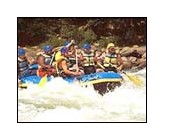 River
Rafting - Ladakh offers many options for undertaking
adventure activities amidst landscapes of spectacular,
rugged beauty. These mainly include river rafting, mountaineering
and trekking. River rafting in Ladakh is quite unlike
anywhere else in the world. It provides the best opportunity
to enjoy and experience the natural beauty of the spectacular
landscape with deep gorges, towering snow-capped peaks,
hilltop monasteries, hillside villages, and glimpses
of the unique wildlife. Ladakh offers a range of rafting
options on the Indus and its major tributaries. The
best stretch for professionally guided runs in white
water is on the Indus between Spituk and Nimu or Saspol,
which rates 2 to 3 in the international river grading
scale of 1 to 6. Upstream of Spituk, the Indus has the
easiest stretch up to Karu, which is ideal for basic
training or "scenic floating". In recent years,
running the Indus has become an attractive option to
complement with sightseeing, and features on the itinerary
of most visitors. Several travel agencies offer all-inclusive
rafting packages. Ask for details at the Tourist Office
at Leh. River
Rafting - Ladakh offers many options for undertaking
adventure activities amidst landscapes of spectacular,
rugged beauty. These mainly include river rafting, mountaineering
and trekking. River rafting in Ladakh is quite unlike
anywhere else in the world. It provides the best opportunity
to enjoy and experience the natural beauty of the spectacular
landscape with deep gorges, towering snow-capped peaks,
hilltop monasteries, hillside villages, and glimpses
of the unique wildlife. Ladakh offers a range of rafting
options on the Indus and its major tributaries. The
best stretch for professionally guided runs in white
water is on the Indus between Spituk and Nimu or Saspol,
which rates 2 to 3 in the international river grading
scale of 1 to 6. Upstream of Spituk, the Indus has the
easiest stretch up to Karu, which is ideal for basic
training or "scenic floating". In recent years,
running the Indus has become an attractive option to
complement with sightseeing, and features on the itinerary
of most visitors. Several travel agencies offer all-inclusive
rafting packages. Ask for details at the Tourist Office
at Leh.
The most difficult but exciting rafting option is available
on the Zanskar River, along its spectacular course through
a gorge in the Zanskar Mountains, between Padum and
Nimu. This is suitable only for well-organized white-water
expeditions, prepared for about a week of rafting and
camping in absolute wilderness. Participants are required
to be trained rafters themselves while the arrangements
should be assigned to a dependable professional agency.
Adequate arrangement for rescue back-up is an essential
prerequisite for embarking upon this white-water expedition.
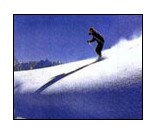 Skiing
in Ladakh Skiing
in Ladakh
Mountain Climbing - The area most frequented by foreign
climbers is the Nun-Kun massif in the Great Himalayan
Range. Its easy accessibility from the Kargil-Padum
road and the shortest possible approach march to the
base camps makes this massif the most attractive climbing
destination in the Great Himalayan, necessitating advance
booking years ahead. Among its six known peaks accessible
from the Suru Valley, Nun (7,135 m) and Kun (7,087 m)
are the highest summits. The area nearest to Leh is
the Stok-Khangri massif in the Zanskar Mountains, south
of Leh. The base camp for the various peaks of this
massif is about two days' trek from the Stok village.
Among its known peaks, Stok- Khangri (6,150 m) is the
highest. It offers a spectacular perspective to the
central expanse of the Indus Valley, which it dominates.
Other peaks in the area include Gulap Khangri (5,900
m), Matho West (5,950 m) and Kantaka (5,275 m). The
much higher Konglacha Peak (6,700 m) lies southwest
of Leh and is reached via Rumbak on the first leg of
the Markha Valley trek from Stok. Besides there are
many unnamed peaks in the altitude range of 5,500 m
to 6,400 m available for climbing.
North of Leh, across the Ladakh Range and the Nubra
Valley, lies the Karakoram Range. It soars to a number
of known peaks which are, however, within the restricted
area and so not freely accessible to foreign climbers
except with special permission from the Government of
India. The most prominent summits in this range, which
are accessible from various parts of the Nubra Valley
include, Saser-I (7,415 m), Saser-II (7,513 m) and Saser-III
(7,495 m).
Pahalgam
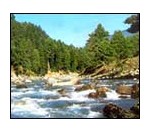 The
Valley of Shepherds - Situated at the confluence of
the streams flowing from Sheshnag Lake and the Lidder
river, Pahalgam (2,130 m) was once a humble shepherd's
village with breathtaking views. Now it is Kashmir's
premier resort, cool even during the height of summer
when the maximum temperature does not exceed 25Deg C.
A number of hotels and lodges cater to all preferences
and budgets, from luxurious hotels to unpretentious
trekkers' lodges, including J&K TDC's huts. The
Valley of Shepherds - Situated at the confluence of
the streams flowing from Sheshnag Lake and the Lidder
river, Pahalgam (2,130 m) was once a humble shepherd's
village with breathtaking views. Now it is Kashmir's
premier resort, cool even during the height of summer
when the maximum temperature does not exceed 25Deg C.
A number of hotels and lodges cater to all preferences
and budgets, from luxurious hotels to unpretentious
trekkers' lodges, including J&K TDC's huts.
Around Pahalgam are many places of interest, and because
the resort is set between fairly steep hills, it is
worth hiring a pony rather than walking. Pony fares
are posted at prominent locations.
The most beautiful of these is the huge, undulating
meadow of Baisaran, surrounded by thickly wooded forests
of pine. Hajan, on the way to Chandanwari, is an idyllic
spot for a picnic. Filmgoers will recognize it instantly
as it has been the location of several movie scenes.
Pahalgam has within it no fewer than eight tiny villages,
one of which is Mamal. There is a Shiva temple here,
generally considered to be Kashmir's oldest existing
temple, dating to the 5th century.
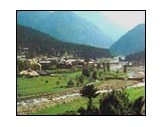 Pahalgam
is also associated with the annual Amarnath Yatra. Chandanwari
(2,895 m), 16 kms from Pahalgam, is the starting point
of the yatra that takes place every year in the month
of Sawan (July to August). The road from Pahalgam to
Chandanwari is on fairly flat terrain and can be undertaken
by car. From Chandanwari onwards the track becomes much
steeper, and is accessible on foot or by pony. About
11 kms from Chandanwari is the mountain lake of Sheshnag
(3,574 m), after which, 13 kms away is the last stop,
Panchtarni. The Amarnath cave is 6 kms away from there.
During the month of Sawan, an ice stalagmite forms a
natural shivling in the Amarnath cave, which waxes and
wanes with the moon. Pahalgam
is also associated with the annual Amarnath Yatra. Chandanwari
(2,895 m), 16 kms from Pahalgam, is the starting point
of the yatra that takes place every year in the month
of Sawan (July to August). The road from Pahalgam to
Chandanwari is on fairly flat terrain and can be undertaken
by car. From Chandanwari onwards the track becomes much
steeper, and is accessible on foot or by pony. About
11 kms from Chandanwari is the mountain lake of Sheshnag
(3,574 m), after which, 13 kms away is the last stop,
Panchtarni. The Amarnath cave is 6 kms away from there.
During the month of Sawan, an ice stalagmite forms a
natural shivling in the Amarnath cave, which waxes and
wanes with the moon.
For detailed information on the Amaranath Yatra, refer
to the Amarnathji Yatra Link, which contains detailed
information on the background of the yatra, the facilities
provided and arrangements made, the routes of yatra,
registration requirements, "do's and don'ts",
etc.
What to Do
Horse Riding - Ponies can be hired directly
or through the Tourist Office. Tariff boards are displayed
at all important locations.
Golf - Pahalgam Club has a 9-hole golf course,
which can be used by tourists. Golf sets can be hired
from the Tourist Office.
Fishing - The Lidder River has excellent fishing
beats for brown trout. The fishing season stretches
from April to September. Permits are issued, for a maximum
of three days at a time, on a first-come - first-served
basis and are charged on a per day per rod basis. Fishing
equipment can be hired in Srinagar. Live baits and spinning
are not allowed. For permits contact the Directorate
of Fisheries, Tourist Reception Centre, Srinagar.
Trekking - The environs of Pahalgam
offer exciting trekking opportunities, the best known
being: Pahalgam - Chandanwari- Sheshnag- Panchtarni-
Amarnath Cave Temple- Sonamarg.
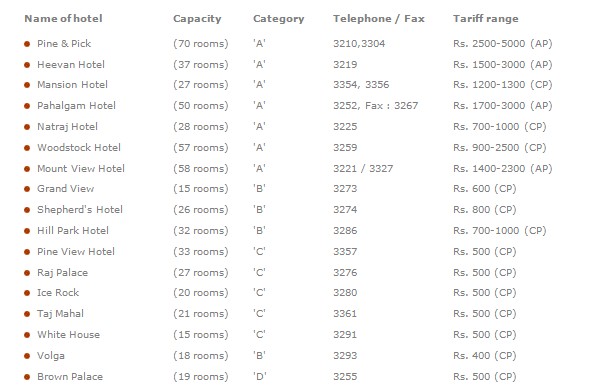
Note :- Besides the above listed hotels, 30 Guest
Houses with bed capacities ranging from 10 to 20 provide
accommodation in the tariff range of Rs.300/- to Rs.800/-
per double room. For details contact the Tourist Officer,
Pahalgam.
Other Accommodation :
J&K TDC offers accommodation in its 26 three/two-bed
room Huts, 19 one -bed room huts , one clubhouse (3
suites) and a 7-roomed Tourist Bungalow at Pahalgam.
The tariff is as under :
One - bed room hut Rs. 800/-
Two- bed room hut Rs. 1500/-
Three -double bedded room hut. Rs. 2000/-
Suites in Tourist Bungalow: Rs. 650/-
Double bed room in Tourist Bungalow: Rs. 300/-
Reservation & Enquiries :
Sr. Manager (Tours & Travel Division),
J&K TDC, Tourist Reception Centre,
Srinagar.
Tel. 457927, 472644,
Fax: 0194- 457927, 476107
E-mail: shamimwani@vsnl.com
Tourist Information
The J&K Govt. Tourist Office is located at the
head of the main bazaar, where the tourist coaches stop.
Tourists are urged to visit the office for all kinds
of information and assistance, and for the latest information
on trekking, hiking and other recreational activities
in Pahalgam. They should make it a point to enquire
from the Tourist Office whether one should proceed on
a particular trek or not.
Patnitop
112 kms from Jammu, this famous hill resort is perched
on a beautiful plateau, at an altitude of 2024 metres
across which the Jammu-Srinagar Highway passes. Enveloped
by thickly wooded forests, Patnitop offers beautiful
picnic spots, peaceful walks and breathtaking views
of the of the Chenab basin. In winter, the resort is
generally covered with a thick mantle of snow thus providing
opportunities for various snow games including skiing.
It is the best-developed tourist spot of Jammu and is
second to none in its natural charm, climate, pine forests
and lush green cover. The occupancy of the huts and
Dak Bungalow is full in summer months. There is an ambitious
plan of Patnitop Development Authority to develop Patnitop,
Kud, Sud-Mahadev, Mantalai circuit. The construction
work of Mall Road at Kud is to be taken up in the near
future. Trekking route from Kud to Patnitop-Sanasar
has already been completed. The complete tourist circuit
covers Jammu-Katra-VaishnoDeviji, Kud-Sanasar, Patnitop-Gourikund,
Sudmahadev, Mantali, extending upto Latti-Dhuna.
Facilities :
Accommodation : There are a large number of huts and
Tourists Bunglows, all managed by J&K TDC, having
facilities of Drawing room/Dining room and fully equipped
kitchen in all huts with cooking gas.
Tariff :
1. Patni Enclave
i) Delux two double bedroom hut Rs. 2500/-
ii) Two double bedroom hut with attached bathroom Rs.
1600/-
iii) Two double bedroom hut with one bathroom Rs. 1500/-
iv) Single double bedroom hut with attached bathroom
Rs. 800/-
2. Huts in Padora Village (Two kilometres from Patni
Enclave)
Double bedroom hut with with attached bathroom Rs. 1600/-
3. Tourist Bungalow No. I & II Double bedroom Rs.
600/-
4. Tented accommodation for economy class (Summer months
only)
Per Tent with allied facilities Rs. 100/-
What to Do
Trekking - A range of trekking options is available
here. Summer is the season when all trekking routes
are open while some are open in winter too. There are
excellent camping sites also enroute. The Sundarani-
Jungal Gali-Jasarkote-Sanasar route in Jangal Gali area
lets you choose any of three exciting treks. There are
Trekking equipment hire shops of tourism Department
at Jammu and Kud. They stock imported and local gear.
These are available for fixed prices.
Equipment available
Tents :
i) 4 man tent
ii) 2 man tent
2. Carry mat
3. Sleeping bags
4. Jackets
5. Windcheaters
6. Rucksacks, Boots
The equipment is issued against cash receipt or on
Guarantee letter from Dy.Dir Tourism/Dy.Secy of State
or central govt. For a foreign tourist Passport is held
as security deposit. Some travel agencies in Jammu city
also organize Trekking in the area.
Amateur skiing at Patnitop
Skiing - Skiing courses are conducted at Patnitop in
the months of January and Feburary. During winter mionths
there are introductory courses for tourists/beginners
at gentle gradient slopes of Patnitop. At Madhatop (5/6
Kms from Patni top on Sanasar Road) excellent possibilities
for all kind of skiing exist. A ski-lift in the area
is also proposed.
As for facilities 40 sets of equipment is available
at Patnitop and Sanasar. Also available are wooden sledges
locally. For beginners Instructors are also available.
Accomodation for Skiers is also available in Huts of
JKTDC at Patnitop,KUD and Sanasar.Private Hotels around
the area also offer accomodation. Restarurants and Dhabas
serve tourists round the year.
Aero sports - Paragliding has been introduced at Sanasar
and Jammu. Equipment is available on Hire from tourist
office in Jammu city. May-June and Septemer October
are best suited for paragliding. Other aero sports like
Parasailing and Hotair ballooning are also becoming
operational shortly.
Srinagar - The Lake City
Srinagar is located in the heart of the Kashmir valley
at an altitude of 1,730 m above sea level, spread on
both sides of the river Jhelum. The Dal and Nagin lakes
enhance its picturesque setting, while the changing
play of the seasons and the salubrious climate ensures
that the city is equally attractive to visitors around
the year.
Kalhana, the author of 'Rajtarangini', states that
Srinagri was founded by Emperor Ashoka (3rd Century
BC). The present city of Srinagar was founded by Pravarasena-II,
and Hiuen Tsang, who visited Kashmir in 631 AD, found
it at the same site as it is today. Laltaditya Muktapida
was the most illustrious ruler of Kashmir in the Hindu
period, which ended in 1339 AD. King Zain-ul-Abidin
(1420-70 AD), popularly known as 'Budshah', was a great
patron of Sanskrit. Akbar captured Kashmir valley for
the Mughals, who endowed Srinagar with beautiful mosques
and gardens. The Sikhs overthrew the last Muslim ruler
in the reign of Maharaja Ranjit Singh in 1819. In 1846
the Dogras secured the sovereignty of Kashmir from the
British under the Treaty of Amritsar, and in 1947 the
state of Jammu and Kashmir with Srinagar as its capital,
became part of the Indian Union.
Today Srinagar is a resort for the tourist who can
experience, at first hand, the peculiar beauty of the
valley that has attracted the Chinese, the Mughals and
the British to it.
Its waterways with their own quaint lifestyle, the
unique Houseboat, the blossoming gardens, water sports
activities, shopping for lovingly handcrafted souvenirs
and the nearby resorts make it a cherished spot among
those looking for a memorable holiday.
General Information
Area 105 sq kms
Altitude 1,730 m.
Temperature Max Min
Summer 29.5 C 10.6 C
Winter 7.3 C 1.9 C Rainfall 52.9 cms
Best Season Throughout the year, though the winter months
can be quite cold.
Clothing Spring and autumn Light woollens. Summer Cotton/tropical,
Winter Heavy woollens
Languages Kashmiri, Urdu, Hindi, English.
Access
By Air - Indian Airlines operate regular daily flights
to Srinagar from Delhi, Mumbai and Jammu. Jet Airways
also operate daily flights to Srinagar from Delhi as
well as Jammu. Srinagar airport is 14 kms from the city.
Note : All foreign visitors are required to register
themselves at the Foreigners Regional Registration Office,
at its Airport counter.
By Rail - The nearest railhead for Srinagar is Jammu
Tawi (305 kms) where trains arrive from Delhi, Kolkata,
Pune, Mumbai, Kanniyakumari, Ahmedabad, etc. During
the holiday season, additional trains operate to and
from various parts of the country.
By Road - National Highway 1-A, connecting Srinagar
with Jammu, is a good, all weather road, with several
sharp inclines and hairpin bends. It is maintained by
the Border Roads Organization (BRO), which clears the
road of any obstructions. The famous Jawahar Tunnel
that connects Jammu with the Kashmir Valley across the
Pir Panjal range. Super deluxe, A-class, B-class busses
are operated by J&K SRTC as well as other transport
agencies. It is also possible to travel by taxi from
Jammu to Srinagar. For those wishing to travel to Srinagar
by a private car from Jammu, there are several places
en route which have been developed for the convenience
of the motorist all having tourist bungalows and provisions
for meals, snacks, petrol pumps and repairs.
Places of Interest
Srinagar's distinctive feature is the great body of
water, the Dal Lake, which forms its focal point. The
Dal has, within its area, two enormous sheet-like expanses
of water-Lokut-dal and Bod-dal, the rest of its surface
being broken up alternatively by man-made strips of
land inhabited by whole colonies of people and vegetation.
Thus the lake is not a flat, unbroken mass of water,
but a labyrinth of waterways, awash with a lifestyle
not found elsewhere in the world.
The Lakes - Leading from the Dal is the smaller
Nagin Lake. Here too, the waters are edged by trees
of willow and poplar whose reflection is mirrored in
the lake. 'Bathing boats' here, as well as on the Dal,
hire out water-skis and motor launches. The waters of
the lakes are pleasantly cool from mid-May to mid-September.
Shikaras can be hired from any of the steps called 'ghats'
(jetties) leading to the lake. Some rides are fixed
and their rates are posted at each ghat as well as opposite
the Tourist Reception Centre. Shikaras are a refreshingly
novel way of seeing Srinagar by day and at twilight,
the gentle soothing motion of the boat, as it glides
along the water, is unbelievably romantic. Nagin Lake
lies to the east of the city at the foot of the Zabarwan
Mountain. The Shankaracharya hill (Takht-i-Sulaiman)
is to the south and Hari Parbat on its west. The lake
is 6x3 km and is divided by causeways into four parts.
Gagribal, Lakut-dal, Bod-dal and Nagin. Lokut-dal and
Bod-dal each have an island in the centre, called Rup
Lank or Char Chinari and Sona Lank, respectively.
The Mughal Gardens - With terraced lawns, cascading
fountains, paint-box-bright flowerbeds with the panorama
of the Dal in front of them - the three Mughal Gardens
of Chesmashahi, Nishat and Shalimar are the Mughal Emperors'
concept of paradise and are today very popular places
for picnics and excursions.
Shalimar Bagh - Built by Emperor Jehangir for his wife
Nur Jehan, Shalimar, 15 kms from the TRC, is a beautiful
garden with sweeping vistas over gardens and lakes,
and shallow terraces. The garden is 539 m by 182 m and
has four terraces, rising one above the other. A canal
lined with polished stones and supplied with water from
Harwan runs through the middle of the garden. The fourth
terrace, by far the best, was once reserved for royal
ladies.
Nishat Bagh - Situated on the banks of the Dal
Lake, with the Zabarwan Mountains as its backdrop, (11
km. from TRC), this 'garden of bliss' commands a magnificent
view of the lake and the snow capped Pir Panjal mountain
range which stands far away to the west of the valley.
Nishat was designed in 1633 AD by Asaf Khan, brother
of Nur Jehan.
Chashma Shahi - At Chashmashahi, is a tastefully
laid garden in terraces, which commands a magnificent
view of the Dal Lake below and surrounding mountain
ranges. The cool water of the spring is highly refreshing
and digestive. The original garden was laid out by Shah
Jehan in 1632 AD. TRC Srinagar free of cost to visit
the permits can be had from the information Counter
Chashma Shahi Garden. Permits can be had from the information
counter.
Pari Mahal - Once the royal observatory, Pari
Mahal has a charmingly laid out garden and is a five-minute
drive from Cheshmashahi. A Buddhist monastery at one
time, it was converted into a school of astrology by
Dara Shikoh, Mughal Emperor Shah Jehan's eldest son.
Situated on the spur of a mountain overlooking the Dal,
the ancient monument, with a well-laid spacious garden
in front, is connected to Cheshmashahi by road. It is
illuminated at night.
Harwan - On the hillside, south of the village
of Harwan (19 kms from the TRC)), remarkable remains
of ancient ornamented tile pavements of the Buddhist
period have come to light. The tiles depict the dresses
of the people, such as loose trousers, Turkoman caps
or close fitting turbans and large ear-rings which reveal
Central Asian influence.
Hazratbal Mosque - Hazratbal Mosque is located
in a village of the same name on the banks of the Dal.
Its pristine white marble elegance is reflected in the
waters of the lake. Hazratbal's special significance
is derived from the fact that it houses a hair of the
prophet Muhammad. This is displayed to the public on
religious occasions, usually accompanied by fairs. Apart
from these occasions, Friday prayers are offered at
Hazratbal and attended by throngs of people. Hazratbal
is remarkable for being the only domed mosque in Srinagar;
the others having distinct pagoda like roofs. The shrine
- mosque complex is situated on the western shore of
the Dal Lake opposite Nishat Bagh and commands a grand
view of the lake and the mountain beyond.
Jama Masjid - The Jama Masjid at Nowhatta, in
the heart of the old city, is the other important mosque
in Srinagar at which thousands of people congregate
for the Friday prayers. Of imposing proportions, the
mosque is built around a courtyard and is supported
by 370 wooden pillars. The hushed quiet of the mosque
counterpoints the bustle of the old bazaars surrounding
it. Originally built by Sultan Sikandar in 1400 AD,
and enlarged by his son, Zain-ul- Abidin, it is a typical
example of Indo-Saracenic architecture. Destroyed thrice
by fire and rebuilt each time, the mosque, as it now
stands, was repaired during the reign of Maharaja Pratap
Singh.
Shankaracharya Temple - The sacred temple of
Shankaracharya occupies the top of the hills known as
Takht-I-Sulaiman in the southeast of Srinagar. The site
dates back to 250BC. The philosopher Shankaracharya
stayed at this place when he visited Kashmir ten centuries
ago to revive Sanatan Dharma. Before this date, the
temple was known as Gopadri, as an earlier edifice on
the same site was built by king Lalitaditya in the 6th
century AD. In fact, the road below the hill, with residences
of high- ranking State Government officials, is still
known as Gupkar road. Built on a high octagonal plinth
and approached by a flight of steps with sidewalls that
once bore inscriptions, the main surviving shrine consists
of a circular cell. It overlooks the Valley and can
be approached by a motorable road. A modern ceiling
covers the inner sanctum and an inscription in Persian
traces its origin to the reign of Emperor Shah Jehan.
The original ceiling was dome- shaped and the brick
roof, it appears, is not more than a century old.
Khanqah of Sha Hamadan - Situated on the banks
of the river Jhelum, between the third and fourth bridge,
it is the first mosque ever built in Srinagar. The original
one was built in 1395. Shah Hamadan's full name was
Mir Sayed Ali Hamadni, the surname being derived from
the city of Hamadan in Persia. Shah-i-Hamdan, who came
from Persia in the 13th century, was responsible for
the spread of Islam in Kashmir. Khanqah-i-Mualla, on
the banks of the Jhelum, was the very spot where Shah-i-Hamdan
used to offer prayers. After staying in Kashmir for
many years, he left for Central Asia via Ladakh. A mosque
established by him at Shey (near Leh) attracts devotees
from far and wide. The Khanqah is a wooden structure
whose chief aesthetic feature is its beautifully carved
eaves and hanging bells. The interiors are richly carved
and painted, and the antique chandeliers give it an
air of opulence.
Hari Parbat Fort - The Mughal emperor's fort
crowns the top of Hari Parbat hill. There is little
left of its former glory, but the ramparts are still
impressive and the old apartments within the fort, even
though in a state of ruin, still convey at least a little
of the grandeur of the Mughals' summer retreat in 'paradise'.
An Afghan governor, Ata Mohammad Khan, later developed
the fort in 18th century. The hill is considered sacred
to the Hindus due to the presence of temple of Sharika,
which is believed to be a form of goddess Durga or Shakti.
The wall around the hill was built by Akbar in 1592-98
AD. The hill is surrounded by almond orchards, which
make a lovely sight during April when the trees blossom,
heralding the advent of spring in Kashmir.
Makhdoom Sahib - On the southern side of the
Hari Parbat hill is the historic shrine of Makhdoom
Sahib, which is visited by people of all faiths.
Chhatti Padshahi Gurudwara - The sixth Sikh
guru travelled through Kashmir, stopping to preach occasionally.
A Gurudwara has been built at the exact site of each
of these halts. The most important one among these is
Chhatti Padshahi Gurudwara, situated near the Kathi
Darwaza, in Rainawari, Srinagar, which is held in great
reverence by devotees of all faiths.
Martand - Martand, located atop a plateau, close
to the township of Anantnag, has a temple dedicated
to Surya, the "Sun God". Built by king Laitaditya
Muktapida (7th to 8th century AD), it is a medieval
temple with a colonnaded courtyard and the shrine in
its centre. The temple complex has 84 columns and offers
a commanding view of the valley of Kashmir.
Kheer Bhawani Temple - The Goddess Ragnya Devi
is symbolised as a sacred spring at Tula Mula village,
27 kms from Srinagar. Within the spring is a small marble
temple. The devotees of the goddess fast and gather
here on the eighth day of the full moon in the month
of May when, according to belief, the goddess changes
the colour of the spring's waters. The temple-spring
complex is affectionately known as Kheer Bhawani because
of the thousands of devotees who offer milk and 'kheer'
to the sacred spring, which magically turns black to
warn of disaster.
The Awantipur ruins - Founded by Avantivarman
who ruled Kashmir in the 9th century, this ancient township
is 29 kms from Srinagar. The site has two imposing temples,
huge walls mark the larger one of Siva - Avantisvara,
some half a mile beneath the town on the outskirts of
village Jaubror. The subsidiary shrines are to the rear
corner of the courtyard. The complex has, over the years,
lost its grandeur and been reduced to ruins, though
it is still visited by the devout. Half a mile up is
Avantisvami - Vishnu, a better preserved, though smaller
temple.
Excursions
Wular Lake - It is difficult to describe in
mere words the beguiling beauty of Wular Lake. For one,
its formidable size - this is one of Asia's largest
fresh water lakes - for another, it changes character
with every few miles.
Manasbal Lake - The drive from Srinagar will
take you to the calm waters of Manasbal Lake, where
there is no other sound but birdsong. Manasbal has often
been described as the bird watcher's paradise, and as
your shikara glides through this mirror of tranquillity,
you will experience yet another facet of Kashmir. Driving
through the town of Bandipora, which has a delightfully
laid out Mughal Garden, the Wular will always be to
your left. Here and there, you will hear women chanting
some age-old ditty as they pick water chestnuts, deftly
navigating the weeds in flat-bottomed skiffs.
Watlab - Gradually, the panoply of the 'real
Kashmir', miles away from well-traversed areas, will
unfold before you, and you will reach Watlab. Here,
high on a hilltop is the shrine of a Muslim mystic,
Baba Shukurddin. From here, the Wular Lake stretches
away as far as the eye can see, edged by picturesque
villages around terraced breeze-rippled fields of paddy,
in a riotous burst of colour. At Watlab there is a Forest
Rest House amidst sprawling apple orchards. You can
rest here to enjoy the sheer grandeur of the spectacular
countryside at leisure.
Achabal - Once the pleasure retreat of Empress
Nur Jehan, Achabal (1,677 m) has a fine garden in the
Mughal style, with its own special charm and character.
It was in Kashmir that the Mughal Garden was brought
to perfection, and Achabal is one such masterpiece.
Situated at the foot of a hill with a row of majestic
chinars framing it, the Mughal garden is a visual delight
with their stepped terraces, formal elegance, ornamental
shrubs, sparkling fountains and falling water. Achabal
is 58 kms from Srinagar, via Anantnag.
Daksum - Past the Mughal Gardens of Achabal,
with their tinkling fountains, through the breathtaking
splendour of the springs at Kokarnag, lies Daksum. Tucked
away in a densely forested gorge at an altitude of 2438
m, Daksum would be completely silent but for the Bringhi
River which gushes through it. Daksum is a walker's
paradise. Up the hills which are swathed in coniferous
trees, past gurgling brooks, the simple, haunting notes
of a flute will waft down to you from where an unseen
shepherd tends his flock. For in the hills surrounding
Daksum, suddenly you will find yourself in grassy meadows
where sheep are taken to pasture. Daksum is a reviving
experience -the bracing mountain air, the solitude,
the densely clad hills, and beyond them, snow covered
mountains, all contribute to Daksum's mystique, making
it the perfect retreat.
Kokernag - Situated in the heart of Bringhi
valley, Kokernag (2,020 m, 70 kms from Srinagar), is
set amidst sprawling gardens fragrant with the bloom
of thousands of flowers. The Kokernag spring bubbles
at seven places at the foot of the forested mountain.
The water of the spring is famous for its medicinal
and digestive properties.
Yusmarg - A two-hour drive from Srinagar ( 47
kms ) will take you to acres upon acres of grassy meadow
ringed by forests of pine, and towering beyond them,
awesome and majestic snow clad mountains. Here are walks
of every sort - a leisurely amble along flower-strewn
meadows or away to where a mighty river froths and crashes
its way over rocks, its mild white foam earning it the
name of Dudh Ganga. Further away, a captivating lake,
Nilnag, is cradled by hills. Nearby are several peaks-Tatta
Kutti and Sang Safed to name a couple of them. About
13 kms from Yusmarg, a short detour away from the Srinagar
road, is Charari- Sharief, the Shrine of Kashmir's patron
saint Sheikh Noor-ud-din or Nund Reshi.
Aharbal - Gradually, the distant rumble becomes
a roar as one approach the waterfall of Aharbal, which
crashes down a narrow gorge. Aharbal is more than just
a waterfall. There are several places to picnic in the
surrounding areas, as well as delightful walks of varying
lengths all over the hillsides. Interesting treks-one
of them to the high altitude lake of Kounsernag at 13,500
ft above sea level-takes off from Aharbal.
Verinag - Located 80 kms from Srinagar at an
altitude of 1,876 m, the spring of Verinag is believed
to be the chief source of the river Jhelum. Construction
of the octagonal base of the spring and the arcade around
it was undertaken by the Mughal Emperor Jahangir and
completed during the reign of Shah Jahan. Down the stream
to the east lie the remains of a Mughal pavilion and
baths. Verinag can be approached through the link road,
which turns off, from the national highway at Lower
Munda
 Sonamarg
- The Meadow of Gold Sonamarg
- The Meadow of Gold
The drive to Sonamarg is through the Sindh Valley which
presents yet another spectacular facet of countryside
in Kashmir. Situated at an altitude of 2730 m, Sonamarg
('The meadow of gold') has, as its backdrop, snowy mountains
against a cerulean sky. The Sindh River that meanders
through the valley abounds with Trout and Mahaseer.
Ponies can be hired for the trip up to Thajiwas glacier,
which is a major local attraction during the summer
months.
Sonamarg is the base of a major trek that passes along
several mountain lakes -Vishansar, Kishansar, Gadsar,
Satsar and Gangabal. Sonamarg is also the take off station
for the drive to Ladakh across the Zojila, a major pass
in the Great Himalayan Range, through which the Srinagar-Leh
Road passes.
Sonamarg is also a base for undertaking the yatra to
the holy Amarnath cave, during Sawan Purnima. For details
about the yatra, refer to the Amaranathji Yatra Link.
Accommodation in Sonamarg is available in J&K TDC's
Huts and Tourist Bungalows. The tariff is Rs. 1400/-
for 2-bed room huts and Rs. 300/- per double room in
Tourist Bungalow. In addition, there are some private
hotels, among which the Hotel Glacier is the best known.
How To Get There
Sonamarg is situated at a distance of 84 kms from Srinagar,
on the Srinagar-Ladakh Road. J&K SRTC operates regular
buses as well as sightseeing buses during the season.
The route passes through the picturesque town of Ganderbal
(21 kms), Kangan (40 kms) and Gund of the Sindh Valley,
before reaching the resort. Spectacular views of the
Harmukh range dominate the horizon all along the route.
Tourist Information & Assistance
The Tourist Office at Sonamarg is within the premises
of the Tourist Complex, behind the cafeteria. Tourists
are advised to visit the office for information and
assistance. In particular, trekking trips into the mountains
should be undertaken only after consulting the Tourist
Office at Srinagar or Sonamarg for safety and feasibility.
Zanskar
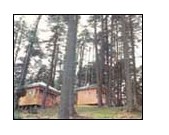 About
20 kms south-east of Rangdum stands the Panzila axis,
across which lies Zanskar, the most isolated of all
the trans-Himalayan valleys. The Penzila pass (4,401m)
is a picturesque tableland surrounded by snow-covered
peaks. About
20 kms south-east of Rangdum stands the Panzila axis,
across which lies Zanskar, the most isolated of all
the trans-Himalayan valleys. The Penzila pass (4,401m)
is a picturesque tableland surrounded by snow-covered
peaks.
As the Zanskar road winds down the steep slopes of
Penzi-la to the head of the Stod valley, the majestic
" Drang-Drung" glacier looms into full view.
A long and winding river of ice and snow, "Drang-Drung"
is perhaps the largest glacier in Ladakh, outside the
Siachen formation. It is from the cliff-like snout of
this extensive glacier that the Stod or Doda tributary
of the Zanskar River rises.
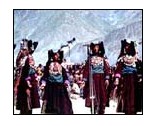 Zanskar
is a tri-armed valley system situated between the Great
Himalayan Range and the Zanskar mountains, the three
arms radiating star-like towards the west, north and
south from a wide central expanse. Here the Zanskar
River comes into being by the confluence of its two
Himalayan tributaries, the Stod/Doda and the Lingti-Tsarap
rivers. It is mainly along the course of this valley
system that the region's approximately 14,000 strong,
mainly Buddhist population, live. Zanskar
is a tri-armed valley system situated between the Great
Himalayan Range and the Zanskar mountains, the three
arms radiating star-like towards the west, north and
south from a wide central expanse. Here the Zanskar
River comes into being by the confluence of its two
Himalayan tributaries, the Stod/Doda and the Lingti-Tsarap
rivers. It is mainly along the course of this valley
system that the region's approximately 14,000 strong,
mainly Buddhist population, live.
Spread over an estimated geographical area of 5000
sq kms of mountainous territory, Zanskar is surrounded
by high-rise mountains and deep gorges.
It remains inaccessible for nearly 8 months a year
due to heavy winter snowfall resulting in closure of
all access passes, including the Penzi-la. This geographical
isolation and the esoteric nature of Buddhism practised
here have enabled its inhabitants to preserve their
identity, so that to-day Zanskar is the least interfered
with microcosms of Ladakh. Closer observation of the
lifestyle evokes admiration for a people who have learnt
to live in perfect harmony with the unique environment.
Within the mountainous ramparts of this 'Shangri-La'
are a number of ancient yet active monastic establishments.
Some of these foundations have evolved around remote
mountain caves, which are by legend associated with
famous Buddhist saints. These are in fact the main places
of attraction for the visitors in the area, in addition
to the haunting beauty of the spectacular landscape
and the ancient culture.
|



